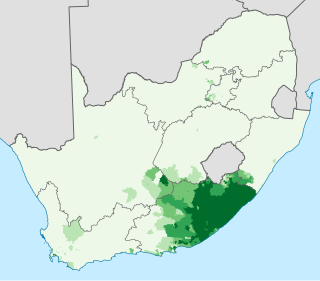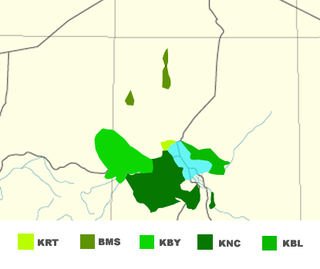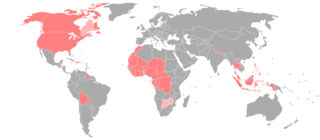Related Research Articles

Xhosa, Xhosa pronunciation: [kǁʰɔ́ːsa](listen)) also isiXhosa as an endonym, is a Nguni Bantu language and one of the official languages of South Africa and Zimbabwe. Xhosa is spoken as a first language by approximately 8.2 million people and by another 11 million as a second language in South Africa, mostly in Eastern Cape, Western Cape, Gauteng and Northern Cape. It has perhaps the heaviest functional load of click consonants in a Bantu language, with one count finding that 10% of basic vocabulary items contained a click.

Kanuri is a dialect continuum spoken by some four million people, as of 1987, in Nigeria, Niger, Chad and Cameroon, as well as small minorities in southern Libya and by a diaspora in Sudan.

Deutsche Welle or DW is a German public state-owned international broadcaster funded by the German federal tax budget. The service is available in 30 languages. DW's satellite television service consists of channels in English, German, Hindi, Spanish, and Arabic. The work of DW is regulated by the Deutsche Welle Act, meaning that content is intended to be independent of government influence. DW is a member of the European Broadcasting Union (EBU).
Sranan Tongo is an English-based creole language that is spoken as a lingua franca by approximately 550,000 people in Suriname.
African-American Vernacular English, also referred to as Black Vernacular, Black English Vernacular (BEV), Black Vernacular English (BVE), occasionally as Ebonics, or simply as Black English (BE), is the variety of English natively spoken, particularly in urban communities, by most working- and middle-class African Americans and Black Canadians.

Modern Standard Arabic (MSA), or Modern Written Arabic, is a term used mostly by Western linguists to refer to the variety of standardized, literary Arabic that developed in the Arab world in the late 19th and early 20th centuries. It is the language used in academia, print and mass media, law and legislation, though it is generally not spoken as a mother tongue, similar to Classical Latin or the literary register of French. MSA is a pluricentric standard language taught throughout the Arab world in formal education. It differs significantly from many vernacular varieties of Arabic that are commonly spoken as mother tongues in the area; these are only partially mutually intelligible with both MSA and with each other depending on their proximity in the Arabic dialect continuum.

Multilingualism is the use of more than one language, either by an individual speaker or by a group of speakers. It is believed that multilingual speakers outnumber monolingual speakers in the world's population. More than half of all Europeans claim to speak at least one language other than their mother tongue; but many read and write in one language. Always useful to traders, multilingualism is advantageous for people wanting to participate in globalization and cultural openness. Owing to the ease of access to information facilitated by the Internet, individuals' exposure to multiple languages is becoming increasingly possible. People who speak several languages are also called polyglots.
Temne is a language of the Mel branch of the Niger–Congo language family, spoken in Sierra Leone by about 2.5 million first-language speakers. One of the country's most widely spoken languages, it is spoken by 36% of the country’s population. It also serves as a lingua franca for an additional 1,800,000 people living in areas near the Temne people. It is closely related to the neighboring Landouma language.
Gogo is a Bantu language spoken by the Gogo people of Dodoma Region in Tanzania. The language is spoken throughout Dodoma Region and into the neighbouring district of Manyoni.

English is a West Germanic language first spoken in early medieval England, which has eventually become the leading language of international discourse in the 21st century. It is named after the Angles, one of the ancient Germanic peoples that migrated to the area of Great Britain that later took their name, England. Both names derive from Anglia, a peninsula on the Baltic Sea. English is most closely related to Frisian and Low Saxon, while its vocabulary has been significantly influenced by other Germanic languages, particularly Old Norse, as well as Latin and French.
Hausa Sign Language (HSL) or Maganar Hannu is the indigenous sign language of the Deaf community in northern Nigeria.
The Bété syllabary was created for the Bété language of Ivory Coast in the 1950s by artist Frédéric Bruly Bouabré.
Fluency is the property of a person or of a system that delivers information quickly and with expertise.

Motswako is a Southern African genre of hip hop popular in Botswana and South Africa. It consists of a mix of rap lyrics in both the local language (Setswana) and English layered on a steady beat. Other languages used include Sesotho, Zulu and Afrikaans as per the rapper's origin. The genre gained popularity in the late nineties as South African acts like HHP and Baphixile started rapping in Setswana, resulting in an increased following from the local population. Because of its reputation in Botswana most of the upcoming artists use this genre as a base before they start their music careers because of its basic principles, a good motswako artist have to learn the creative writing skills used to perfect the genre making it easy to learn and write music. Today there is a high pool of motswako artists in Botswana and South Africa with few females artists.
The Northeast Bantu languages are a group of Bantu languages spoken in East Africa. In Guthrie's geographic classification, they fall within Bantu zones E50 plus E46 (Sonjo), E60 plus E74a (Taita), F21–22, J, G60, plus Northeast Coast Bantu. Some of these languages share a phonological innovation called Dahl's law that is unlikely to be borrowed as a productive process, though individual words reflecting Dahl's law have been borrowed into neighboring languages.
Kimbu may be:
Brem (Barem), also known as Bunabun, is a Papuan language of Sumgilbar Rural LLG, Madang Province, Papua New Guinea.
The Mwangwego script is an abugida developed for Malawian languages and other African Bantu languages by Nolence Mwangwego. It is one of several indigenous scripts invented for local language communities in Africa.

American Sign Language (ASL) developed in the United States and Canada, but has spread around the world. Local varieties have developed in many countries, but there is little research on which should be considered dialects of ASL and which have diverged to the point of being distinct languages.
References
- ↑ Kimbu at Ethnologue (18th ed., 2015)
- ↑ Jouni Filip Maho, 2009. New Updated Guthrie List Online
- ↑ Brenzinger, Matthias (1992). Language death : factual and theoretical explorations with special reference to East Africa. Walter de Gruyter. pp. 90–91. ISBN 9783110134049.
- ↑ Gabriel, Helena (2018). "A Case Study of Kimbu Intergenerational Transmission" (PDF). Arusha Working Papers in African Linguistics. 1: 38–53. Retrieved 8 April 2019.